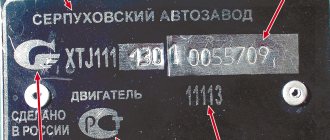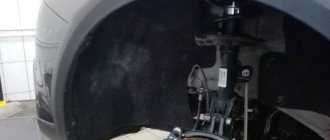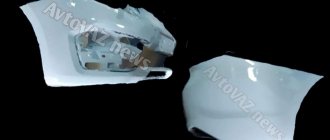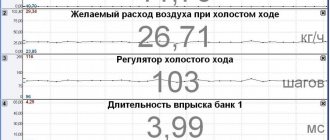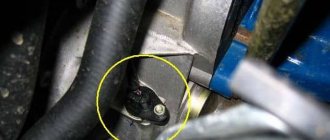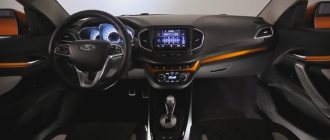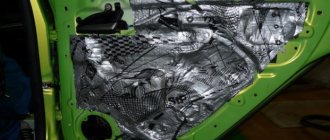Where is the VIN number of the Lada Vesta SV Cross located?
The VIN number of the Lada Vesta SV Cross is located in two places - on the right central pillar of the car, as well as under the hood on the side wall of the engine compartment. In addition, there is a duplicate plate on the central pillar, like most Japanese cars. However, Vesta does not have a VIN number under the seat or under the windshield. To verify this, you can go to our website and find this information there.
This is what the VIN looks like on the right center pillar of a white Lada Vesta SV Cross:
And here is a duplicate sign:
Here is an example of the Vest's VIN number under the hood:
Decoding the information on the duplicate plate
1 — Company 2 — Vehicle approval number 3 — Identification number (VIN) 4 — Permitted maximum vehicle weight 5 — Permitted maximum vehicle weight with trailer 6 — Permissible front axle load 7 — Permissible rear axle load 8 — Spare parts code 9 — Engine model 10 — Vehicle equipment
Unfortunately, there is no Lada Vesta color number, as is done on many foreign cars.
Engines for Largus
The body is a body, but the car must be driven by something. The manufacturer did not reinvent the wheel and installed engines from Logan on Largus:
- K7M with 8 valves - 86 hp;
- K4M with 16 valves - 105 hp.
But, there is a domestic development, the engine from Vesta - VAZ 11189. It is also installed on Largus. In fact, this is an engine from Granta, only converted to Euro 5 standards.
We are interested in the last 2 engines: the French one with 16 valves and ours with 8 valves. It’s interesting to know what reviews car enthusiasts write about Largus with a VAZ engine. And of course, compare them with reviews of a foreign-made 16-valve engine.
Decoding the VIN identification number of Lada Vesta
For example, you have a Lada Vesta SV Phantom with VIN number XTAGFL120GY000000 . Let's figure out in order what each of the digits of this number means.
XTA - the first three characters indicate the manufacturer's code in the international format GFL120 - the 4th to 9th characters indicate the vehicle model G - the 10th character indicates the year of manufacture of the vehicle Y000000 - the 11th to 17th characters indicate the serial number of the vehicle.
Symbols for the year of manufacture of the car:
| Vehicle model year | Symbol |
| 2015 | F |
| 2016 | G |
| 2017 | H |
| 2018 | J |
| 2019 | K |
| 2020 | L |
| 2021 | M |
| 2022 | N |
As you may have noticed, the year of manufacture of the car is encrypted using a letter of the Latin alphabet. Vesta production began in 2015, which corresponds to the letter F. Then the years go alphabetically, i.e. 2021 - G, 2021 - H, etc.
History of creation
After Briton Steve Mattin came to the post of chief designer, he immediately began work on the new face of the company in the form of a completely new car, unlike any previously produced by domestic manufacturers. The compact urban crossover, named Lada XRAY, became just such a car.
The history of the Lada XRAY crossover began with the announcement of a tender for the vision of a new concept car, the winners of which were young designers Evgeny Tkachev (Moscow), who developed the exterior design, and Nikolay Suslov (St. Petersburg), who showed a new vision of the interior. Based on the sketches of designers in Togliatti, they developed a mock-up of a conceptual crossover, and a life-size model was already created by an Italian company. And in August 2012, at the Moscow Automobile Salon, the first conceptual urban crossover Lada XRAY was presented for the first time, AvtoVAZ spent about $1 million to create a single copy of it.
In the form of the just presented concept, AvtoVAZ demonstrated a long-term plan for the development of the Lada car lineup, and the project did not go unnoticed; at the first show, the car was literally greeted with applause. Two years later, in August 2014, AvtoVAZ presented a second, more developed version of the concept car, designated as Lada XRAY Concept 2, in this form the car was already ready for mass production.
Serial assembly of the Lada XRAY urban crossover began in December 2015, a little later than the serial production of the Lada Vesta sedan, created in the same X-graphics style, began. However, unlike the sedan, which is produced in Izhevsk, the Lada XRAY crossover is produced in Tolyatti. The official start of sales of the car began in February 2021. At the beginning of 2021, the Lada XRAY crossover is available in three main trim levels, with a total of 12 trim levels. The price for the basic Lada XRAY model in the Optima configuration is 550 thousand rubles, taking into account the maximum benefit from current promotions (without them it is 50 thousand more expensive), top-end configuration, which is called Top, will cost 779 or 829 thousand rubles, respectively.
What to do if the plate with the VIN number of the Lada Vesta is lost due to an accident or repair?
There are cases when the plate with the VIN number of the Lada Vesta is on. This happens most often due to an accident. As a result of the crash test of the Lada Vesta Cross, namely a side impact, the central pillar goes into the cabin. If the vehicle has been damaged and the B-pillar needs to be replaced, the identification plate cannot be restored. The further fate of such a car will be in the hands of a traffic police officer who will check the license plates. If there are no questions about the authenticity of the VIN number under the hood, then there will be no problems with registering the car. However, if there is even the slightest suspicion, the car will be sent for examination. If no crime is found behind the car, then you can go back to check the license plates and register the car.
Design and construction
The design of the Lada XRAY car contains more than 600 original parts, 70% of which are manufactured in Russia.
Externally, the 5-door crossover boasts a stylish design; it is completely unlike any previously produced domestic car. The new stylish radiator grille and embossed sides of the body catch your eye. At the front of the car there is an X-shaped radiator grille made of lacquered black plastic, in the center of which is the new AVTOVAZ logo. In the lower part of the front end there are round fog lights, and on top there are headlights located slightly at an angle. This design gives the car some aggressiveness. The surface of the car's wings and doors also received a distinct X-shaped relief, which is visible to the naked eye. It is also worth noting the original shape of the hood, the stylishly curved roof, the smooth lines of the rear with stylish lights and the original 15, 16 or 17-inch wheels. The crossover turned out to be quite compact and at the same time dynamic. The length of the body, which is 4165 millimeters, allows you to easily maneuver in dense city traffic.
The interior of the car is no less impressive - anatomical seats, pockets in the door trim, a retractable container under the front passenger seat, and even a cooled glove box. Since the car's trunk is located in the cabin, the rear seats fold in a 60/40 ratio, thereby increasing the luggage compartment for transporting large cargo. By the way, the trunk floor is double and when the rear seats are folded, a continuous, flat area is formed. There are special plastic niches behind the rear wheel arches. The trunk volume in the passenger version is 361 liters, and if the rear seats are folded down, the volume increases to 1207 liters.
About engines for Lada Largus
The Lada Largus station wagon was created on the Renault Logan MCV platform in 2012. The power units on the Lada Largus are 8 and 16 valve engines from Renault Logan - the traditional K7M 8 with a power of 86 “horses” and the modern K4M with 16 valves and a performance of 105 hp.
There is also a Lada Largus with a VAZ-11189 engine from LADA Vesta, but essentially this is the same engine 11186 from Granta, but already tuned to Euro-5 eco-standards.
Engine Renault K7M 710/800 1.6 8V
The power unit of the Renault Logan K7M 710 with a volume of 1.6 liters and a power of 89 “horses” is the same K7J 1.4 L, but with an increased piston stroke (up to 80.5 mm), an increased block height, a clutch expanded in diameter, and an enlarged flywheel and a different shape of the gearbox housing.
Like its low-volume counterpart, the Renault K7M 710 engine is designed in the old fashioned way: with rocker arms and a vague oil pump drive system from Renault with a lower shaft, produced in the 60s.
However, with careful treatment of the engine, timely maintenance, and changing the oil twice as often as indicated in the instructions, the engine will run more than 400 thousand kilometers.
In 2010, there were changes in engine power: it was brought up to the Euro 4 eco-standard, productivity was reduced to 83 hp. and called K7M 800.
The main disadvantages of the Renault K7M 710/800 1.6 8V include high fuel consumption, floating speed at idle, valves that require adjustment every 20-30 thousand km, the absence of hydraulic compensators and a timing belt drive that requires replacement every 60 thousand km. Also disadvantages include crankshaft oil seal leakage, noisy engine operation and vibration.
If there is a choice between 1.4 or 1.6 8 valve, then experts recommend an engine volume of 1.6 liters, since a smaller volume does not have strong characteristics.
If you remove the catalyst, then the Logan K7M 800 engine will have the same performance as before - 86 hp. And when installing an exhaust and sports firmware, the engine can produce a couple more “horses,” but apart from fuel consumption, you won’t have to expect any special changes.
Engine Renault K4M 1.6 l. 16
Before you get under the hood of the Lada Largus, the Renault K4M 1.6 liter engine. visited Renault Megane, Renault Clio II, Renault Laguna and other models.
This modification of K4M 1.6 is an evolution of the K7M series with a different cylinder head with 16 valves.
The Renault K4M 1.6 L 16 engine differs from its predecessors in a different head with a pair of lightweight camshafts, different pistons, hydraulic compensators and more. The motor may contain a phase regulator, and the compression ratio varies between 9.5 and 10. In this regard, there is a slight variation in the power characteristics of the engine, but everything else in the K4M is identical.
The disadvantages of the motor include the high price of spare parts. There are failures in engine operation, and if the fuel is of poor quality, the speed begins to fluctuate. When the timing belt breaks, the valves bend and therefore the belt and rollers need to be changed every 60 thousand km. The wheel position sensor and ignition coil can cause floating speed and unstable operation of the K4M.
Compared to an 8-valve engine, the 16V is quieter, more economical and vibration-free.
| K7M 710/800 1.6 8V | Renault K4M 1.6 l. 16 | |
| Production | Automobile Dacia | Renault Espana/AvtoVAZ |
| Engine make | K7M | K4M |
| Years of manufacture | K7M 710 (2004 - 2010), K7M 800 (2010 - present time) | 1999 - our time |
| Cylinder block material | cast iron | Cast iron |
| Supply system | injector | Injector |
| Type | in-line | Row |
| Number of cylinders | 4 | 4 |
| Valves per cylinder | 2 | 4 |
| Piston stroke, mm | 80,5 | 80,5 |
| Cylinder diameter, mm | 79,5 | 79,5 |
| Compression ratio | 9,5 | 9,5 |
| Engine capacity, cc | 1598 | 1598 |
| Engine power, hp/rpm | 86/5500 | 102-115/5750 |
| Torque, Nm/rpm | 128/3000 | 145-147/3750 |
| Fuel | 92 | 92 |
| Environmental standards | Euro 3 | Euro 4 |
| Engine weight, kg | ||
| Fuel consumption, l/100 km (for Celica GT) - city - highway - mixed. | 10 5,8 7,2 | 11,8 6,7 8,4 |
| Oil consumption, g/1000 km | Up to 500 | Up to 500 |
| Engine oil | 5W-40 5W-30 | 5W-40 5W-30 |
| How much oil is in the engine | ||
| Oil change carried out, km | 7500 | |
| Engine life, thousand km - according to the plant - in practice | 400 400+ | No data 400+ |
| Tuning - potential - without loss of resource | No data +/- 120 hp | |
| The engine was installed | Renault Logan Renault Sandero Lada Largus | Renault Logan Renault Sandero Renault Kangoo 1 and 2 Renault Duster Lada Largus Renault Megane 1, 2, 3 Nissan Almera G11 Renault Clio 2 Renault Laguna 1, 2 Renault Scenic Renault Fluence |
The American Dream remains a reality. Cadillac introduced new crossovers
See all photo news >>
Let's sum it up
The owners today have gained considerable experience in using LADA Largus in various fields and industries. They all nod their heads contentedly when asked about the convenience and practicality of the trunk. On the Internet you will find only a limitless mass of positive reviews about this model.
The size of the trunk turned out to be sufficient for the car to effectively demonstrate its functionality and be able to take the lead from competitors “touching on their heels.” The manufacturer managed to competently and rationally arrange the body space, which allows the station wagon to effectively cope with large objects, demonstrating an enviable carrying capacity. We definitely note that we recommend purchasing this station wagon for those who have not yet found a real “hard worker” as a companion, possessing a full range of balanced consumer and technical properties.
Video review of the LADA Largus luggage compartment:


